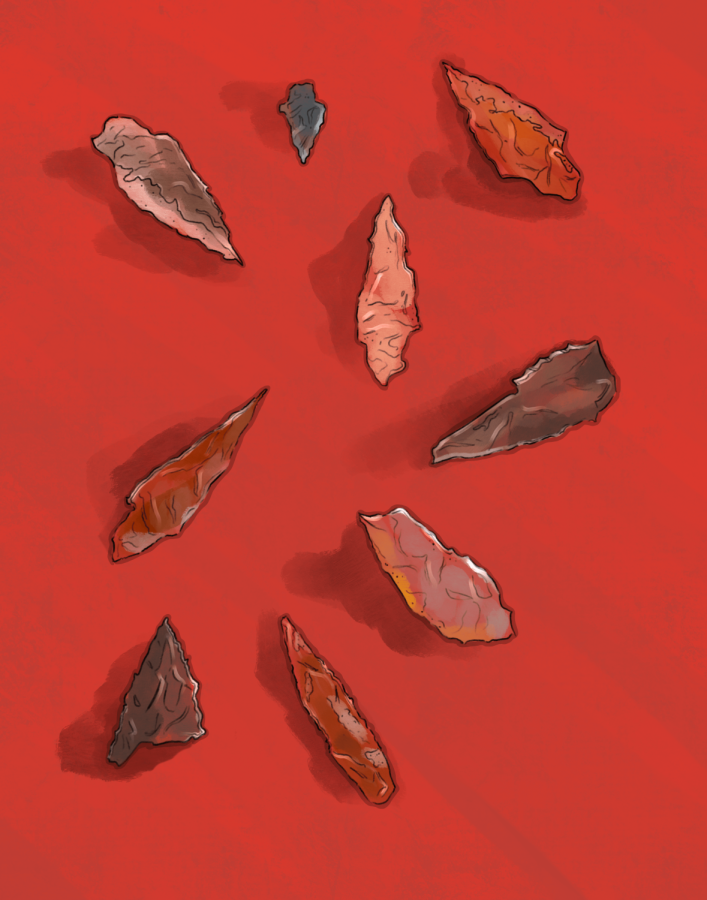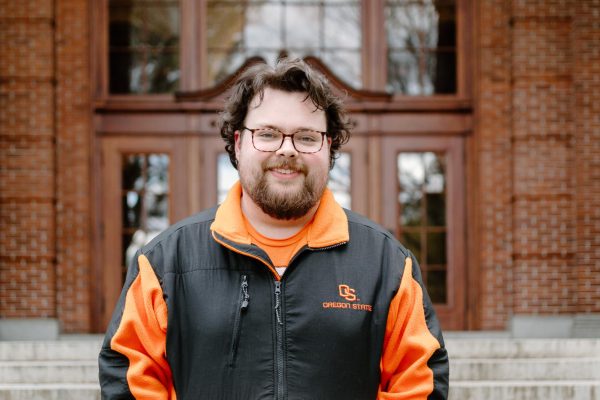OSU archaeologists unearth oldest projectile points found to date in the Americas
February 6, 2023
In western Idaho’s Salmon River Canyon, near where the state’s borders with Oregon and Washington converge, sits Cooper’s Ferry. On the surface, one may not realize the site, a popular spot for camping in the fall, was the location of significant archaeological research.
Archaeologists, however, went there to study what’s under the surface.
An archaeology team at the site, led by an Oregon State University professor, uncovered the oldest projectile points in the Americas, along with other artifacts found while teaching OSU archaeology students.
A group of 14 projectile points found at the site date back to approximately 16000 years ago, according to the team’s paper. A projectile point is the tip at the end of something like an arrow, spear or dart.
The team, whose findings were recently published in the scientific journal Science Advances, worked at Cooper’s Ferry between 2009 and 2018. In the process of working this team turned up artifacts ranging in age from 9,000 years old to 16,000 years old, according to Loren Davis, an OSU professor of Anthropology and head of the research group at Cooper’s Ferry.
The projectile points recovered at Cooper’s Ferry are thousands of years older than any other projectile point found until now in the Americas. According to Davis, the projectile points found at Cooper’s ferry are likely from darts for an atlatl, a type of device used to throw darts or spears at a target.
According to Davis, the first research done at Cooper’s Ferry took place in the 1960s, and this left plenty of unanswered questions. Afterwards, the site was left alone, and by the 1980’s vandals were digging up artifacts, according to David Sisson, an archaeologist with the Bureau of Land Management, which owns the land Cooper’s Ferry sits on.
Sisson, an OSU graduate who has been with the BLM’s field office in Cottonwood, Idaho since 1978, said that the first active management of the site was to cover it up with rocks from a nearby rock slide.
“That did a pretty good job, that stopped all the digging,” Sisson said.
In 2008, Davis and Sisson met with the tribal council of the Nez Perce, on whose traditional lands Cooper’s Ferry is located, to discuss beginning a new excavation on the site.
“They wrote a letter of support for the project, and said it’d be worthwhile,” said Davis.
In 2009, work began anew, and this time plans called for a much larger excavation, which necessitated far more people to work on the project.
“You need a lot of people, and we didn’t have the funding to pay 20 people, and a professor and all the vehicles and restrooms and all that stuff that was needed,” Sisson said. “So the only way was to do that through the school.”
So, the dig was turned into an educational experience, with OSU, in partnership with the BLM, organizing an archaeology field school at Cooper’s Ferry, according to a BLM press release. The site served as a classroom for archaeology students both from OSU and other universities, As well as interns from the Nez Perce Tribe.
Students who signed up for the program earned credits for their work, as well as learning how to live and work in the field, according to Davis.
The class at Cooper’s Ferry ran from 2009 to 2018, with Davis leading the program and Sisson coordinating the partnership between OSU and the BLM. Over those ten years, Davis estimates the field school averaged between 10 and 25 a year, and Sisson believes that around 150 people took part in total.
Beyond the projectile points, the site yielded other notable findings. The team found pits containing artifacts and bone fragments, Sisson said, and according to Davis they also found the remains of what they think may be prehistoric dwellings.
Today, the site of the excavation is marked by three interpretive panels and an information kiosk. Sisson said that there are no further plans for Cooper’s Ferry right now, and both Sisson and Davis emphasized the importance of preserving the rest of the site for future research.
“There’s an ethical obligation not to excavate the entire site, because in the future, technology will improve, we hope, and people will be able to do archaeology in ways we can’t even dream of,” Davis said.
The pit itself was filled in back in 2018, after the team had reached the bottom of the archaeologically-significant portion of the site.
“We got down to the bottom of our excavations, and we thought that we had probably collected enough of a sample to be able to satisfy our original research goals,” Davis said.
OSU’s field school program has moved on to the Oregon coast. According to Davis, last summer’s field school took place at a site near Bandon, and will return in August.
“We’re excavating there because it’s right on the edge of the ocean, and sea level, as it’s starting to rise…will destroy sites like this that are right on the edge of the beach,” Davis said.
Of everything recovered over the ten years at Cooper’s Ferry, around 65,000 items have been cataloged to date, although according to Davis, the total number may be up to 250,000. Plans are also underway to create virtual exhibits of the recovered artifacts.
“We don’t have a big museum here at OSU, but that doesn’t mean we can’t imagine ways to share information about sites like the Cooper’s Ferry site,” Davis said.
The exhibits will eventually be displayed on the fourth floor of Fairbanks Hall. Davis said that the exhibits will be developed over the next few years.
“Students can come work with us, learn how to do 3D scanning or other kinds of creative media expressions of how to talk about artifacts and how they relate to the past. We’re trying to get a lot of different voices,” Davis said.
Sisson, meanwhile, expects that the artifacts recovered from Cooper’s Ferry will be contributing to archaeological knowledge for a long time to come.
“Studies are never really done, and people will come up with different things to do research on at some point,” Sisson said.


















































































![Newspaper clipping from February 25, 1970 in the Daily Barometer showing an article written by Bob Allen, past Barometer Editor. This article was written to spotlight both the student body’s lack of participation with student government at the time in conjunction with their class representatives response. [It’s important to note ASOSU was not structured identically to today’s standards, likely having a president on behalf of each class work together as one entity as opposed to one president representing all classes.]](https://dailybaro.orangemedianetwork.com/wp-content/uploads/2025/03/Screenshot-2025-03-12-1.00.42-PM-e1741811160853.png)

























